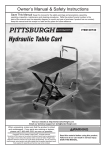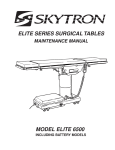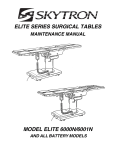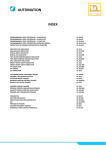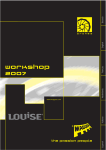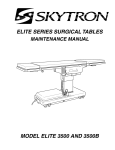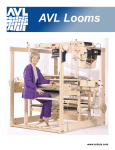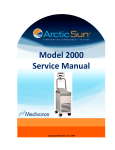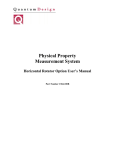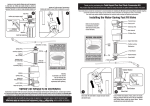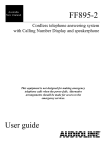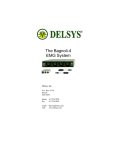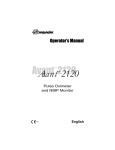Download SKYTRON 3600 O/R Table Service Manual
Transcript
SURGICAL TABLE MAINTENANCE MANUAL MODEL 3600B ULTRASLIDE REV 1/07 Page 1 TABLE OF CONTENTS Title Page Basic Recommended Tools & Maintenance Procedures ......................................................................... 3 Equipment Lables & Specifications .......................................................................................................... 4 Table & Electrical Specifications .............................................................................................................. 5 SECTION I HYDRAULIC SYSTEM ......................................................................................................... 7 1-1. 1-2. 1-3. General ......................................................................................................................................... 7 Component Operation .................................................................................................................. 8 a. Motor/Pump Operation ............................................................................................................. 8 b. Pressure Relief Valve ............................................................................................................... 8 c. Mini-Valves ............................................................................................................................... 9 d. Hydraulic Cylinders (Slave Cylinders) .................................................................................... 11 e. Elevation Cylinder Return Circuit ........................................................................................... 13 f. Brake System ......................................................................................................................... 13 g. Emergency Brake Release ..................................................................................................... 14 h. Flex/Reflex System ................................................................................................................. 14 Hydraulic Adjustments ................................................................................................................ 15 a. Fluid Level .............................................................................................................................. 15 b. Bleeding The Hydraulic System ............................................................................................. 15 c. Pressure Relief Valve ............................................................................................................. 15 d. Speed Controls ....................................................................................................................... 16 SECTION II MECHANICAL TABLE ADJUSTMENTS ........................................................................... 17 2-1. 2-2. 2-3. 2-4. 2-5. 2-6. Back Section Gear Mesh Adjustment ......................................................................................... 17 Hydraulic Cylinder Adjustment .................................................................................................... 17 a. Back Section .......................................................................................................................... 17 b. Leg Section ............................................................................................................................ 18 c. Trendelenburg Cylinder Ball Joint ........................................................................................... 18 Head Section Adjustment ........................................................................................................... 18 Slide Roller Adjustment ............................................................................................................... 19 Side Rails ..................................................................................................................................... 19 Casters .........................................................................................................................................19 SECTION III HYDRAULIC TROUBLESHOOTING ............................................................................... 21 3-1. 3-2. 3-3. 3-4. 3-5. 3-6. Precautions ................................................................................................................................. Troubleshooting Notes ................................................................................................................ ELEVATION DIAGNOSIS CHART ............................................................................................. TRENDELENBURG DIAGNOSIS CHART ................................................................................. LATERAL - TILT DIAGNOSIS CHART ....................................................................................... FLEX SYSTEM DIAGNOSIS CHART .......................................................................................... 21 21 22 23 24 25 REV 1/07 Although current at the time of publication, SKYTRON’S policy of continuous development makes this manual subject to change without notice. Page 2 TABLE OF CONTENTS (continued) Title 3-7. 3-8. 3-9. 3-10. 3-11. 3-12. 3-13. Page BACK SECTION DIAGNOSIS CHART ........................................................................................ LEG SECTION DIAGNOSIS CHART .......................................................................................... SLIDE DIAGNOSIS CHART ........................................................................................................ KIDNEY LIFT DIAGNOSIS CHART ............................................................................................ BRAKE CIRCUIT DIAGNOSIS CHART ...................................................................................... Flexible Hose Identification and Placement ................................................................................ Kidney Lift System ....................................................................................................................... 26 27 28 29 30 31 32 SECTION IV ELECTRICAL SYSTEM ................................................................................................... 34 4-1. 4-2. General ....................................................................................................................................... 34 Components ............................................................................................................................... 34 SECTION V ELECTRICAL TROUBLESHOOTING ............................................................................... 36 5-1. 5-2. 5-3. 5-4. 5-5. 5-6. 5-7. 5-8. 5-9. 5-10. 5-11. 5-12. 5-13. General ....................................................................................................................................... Troubleshooting Notes ................................................................................................................ Main Switch ................................................................................................................................ Batteries ...................................................................................................................................... Capacitor / Rectifier / AC120V Transformer ................................................................................ Pendant Control .......................................................................................................................... Auxiliary Switches ....................................................................................................................... Relay Box ................................................................................................................................... Main Wire Harness Continuity Tests .......................................................................................... Solenoids .................................................................................................................................... Motor/Pump Assembly ................................................................................................................ Return-to-Level / Positioning Inhibit Micro-Switches ................................................................... Micro-Switch Troubleshooting ..................................................................................................... WARNING Indicates a possibility of personal injury. CAUTION Indicates a possibility of damage to equipment. NOTE Indicates important facts or helpful hints. 36 36 36 37 38 39 41 42 44 45 46 47 48 Page 3 BASIC RECOMMENDED TOOLS: 1/8". 1/4" STRAIGHT BLADE SCREWDRIVERS #2 PHILLIPS SCREWDRIVER HYDRAULIC PRESSURE GAUGE SKYTRON P.N. 6-050-02 METRIC ALLEN WRENCHES 1.5mm-8mm ADJUSTABLE CRESCENT WRENCH DIGITAL VOLTMETER, TRUE RMS METRIC OPEN END WRENCHES 7mm-18mm LEVEL (CARPENTERS) GREASE GUN BEARING GREASE P.N. D6-010-89-1 BASIC RECOMMENDED MAINTENANCE PROCEDURES The basic items notes below should be inspected at a minimal interval period of 6 months (dependant on usage). For optimal usage, safety and longevity of the product, have it serviced only by an authorized Skytron representative with authentic Skytron replacement parts. • Check Power Cord (if applicable) • Check Pendant Control (if applicable) • Check Oil Level in Reservoir • Check For Hydraulic Leaks • Check Pressure Relief Valve Setting • Check All Table Functions • Check Side Rails and Gravity Stops • Check Velcro • Check Lateral Tilt Housing Bolts • Lubricate Elevation Slider Assembly with Mobilux EP (Extreme Pressure) Grease P/N D6-010-89-1 • Tighten X-Ray Top Stand-Offs, Use Blue Loc-Tite • Lubricate Casters • Check brake pads for wear and inspect brake cylinders for proper operation. • Inspect the Trendelenburg Cylinder & Ball Joint Retainer Nut Only facility-authorized Skytron trained, maintenance personnel should troubleshoot the Skytron 3600B Surgical Table. Trouble shooting by unauthorized personnel could result in personal injury or equipment damage. How to contact us: SKYTRON 5000 36th St. SE, Grand Rapids, MI 49512 PH: 1-800-759-8766 (SKY-TRON) FAX: 616-957-5053 Page 4 EQUIPMENT LABELS AND SPECIFICATIONS INDICATES DANGEROUS VOLTAGE, 120 V, 60 Hz TYPE B EQUIPMENT CLASS I DEFIBRILLATION PROOF, TYPE B EQUIPMENT- IPX4 RATED. INTERNALLY POWERED EQUIPMENT PROTECTIVE GROUNDING. IN ORDER TO ENSURE PROPER GROUNDING RELIABILITY, THIS TABLE MUST BE CONNECTED TO A PROPERLY GROUNDED HOSPITAL GRADE OUTLET. N CONNECTION FOR NEUTRAL CONDUCTOR SUPPLIED UNIT TO BE USED ONLY IN SPECIFIED ENVIRONMENTAL CONDITIONS TEMPERATURE: 15˚ - 30˚ C (60˚ - 85˚ F) HUMIDITY: 30% - 60% RELATIVE HUMIDITY, NON CONDENSING AC VOLTAGE IPX4 ENCLOSURE CLASS V VOLTAGE RATING OF THE UNIT A AMPERAGE RATING OF THE UNIT HZ FREQUENCY OF THE UNIT ATTENTION, CONSULT MANUAL FOR FURTHER INSTRUCTIONS. INDICATES SPECIAL USER ATTENTION. POWERED BY AC VOLTAGE POWERED BY BATTERY BATTERY TYPE: SEALED LEAD ACID 12V, VALVE REGULATED 16AH, 10HR (530W/10MIN) 15A 15 AMP INTERNAL CIRCUIT BREAKER Page 5 3600B UltraSlide General Purpose Surgical Table Specifications 14-1/2" 12-1/2" 18-1/4" 25" 23" 14-1/2" 19-3/4" TOP VIEW 82" 60˚ 5-3/4" 22" 3" 90˚ 42-1/2" MAX 24" MIN 5-3/4" 8-3/4" 40-3/4" SIDE VIEW ENTELA CERTIFIED TO UL2601-1 CAN/CSA601.1, IEC 60601-2-46 SERIAL NUMBER TAG 19" END VIEW Electrical Specifications Power requirements 120 VAC, 60Hz, 450 Watts Less than 100 micro amps Current Leakage 15 feet w/hospital grade Power Cord connector (removable) Page 6 Page 7 SECTION I HYDRAULIC SYSTEM 1-1. General The hydraulic system (with the exception of the hydraulic cylinders and hoses) is contained within the base of the table. The hydraulic valves and pump are electrically controlled by the use of a hand-held push button pendant control. The power requirements for the table are 120 VAC, 5 amp, 60 Hz. c. Pressure Relief Valve - Provides an alternate oil path when the hydraulic cylinders reach the end of their stroke. The table contains the following components. Refer to the block diagram (figure 1-1) for relationship. e. Hydraulic Lines, Fittings, Connections - They provide a path for the hydraulic oil. a. Oil Reservoir - Main oil supply. Approximately two quarts. f. Hydraulic Cylinders - They convert the hydraulic fluid pressure and volume into mechanical motion. d. Electro/Hydraulic Mini-Valve Assemblies -These direct the fluid to the appropriate hydraulic cylinders. b. Motor/Pump Assembly - A positive displacement gear type pump provides the necessary oil pressure and volume. 13 12 SLIDE 2 5 4 10 6 BACK SECTION 7 TILT CYLINDER 11 KIDNEY LIFT 8 LEG SECTION 9 3 TRENDELENBURG CYLINDER 1 ELEVATION CYLINDER EMERGENCY BRAKE RELEASE (4) BRAKE ASSEMBLIES 4 2 PLUMBING TERMINAL 1 3 5 10 8 6 7 9 14 11 12 13 MINIVALVES BRAKE 1 2 3 4 5 ELEV TREND TILT 2 7 FLEX 6 7 BACK 8 9 10 11 12 13 LEG KIDNEY SLIDE MOTOR/ PUMP ASSEMBLY 82205-101 Figure 1-1. Hydraulic Block Diagram Page 8 1-2. Component Operation a. Motor/Pump Operation The motor/pump assembly is a gear type pump that provides the oil pressure and volume for the entire hydraulic system. The pump has an inlet side and an outlet side. The inlet side is connected to the reservoir which provides the oil supply. The reservoir has a very fine mesh screen strainer which prevents foreign material from entering the oil system. The output line of the pump is connected to the main oil galley which is internal and common to all the hydraulic mini-valves and pressure relief valve. Also, common to the hydraulic mini-valves and pressure relief valve is an oil galley that internally connects to the oil reservoir to provide a return path for the hydraulic oil. See figure 1-2. MAIN PRESSURE OIL GALLERY (internal) MINI-VALVES The main component of the valve is an adjustable spring loaded plunger that when it is pushed off from its seat by the oil pressure the oil then flows back into the reservoir. See figure 1-4. Turning the adjustment nut clockwise increases the amount of oil pressure required to open the valve, and turning it counterclockwise decreases the amount of oil pressure. (See adjustment section for specification.) PRESSURE RELIEF ADJUSTMENT NUT SPRING LOADED PLUNGER PRESSURE GAUGE PRESSURE PRESSURE RELIEF VALVE RETURN OIL RESERVOIR MAIN RETURN OIL GALLERY (internal) 82205-103 Figure 1-3. Pressure Relief Valve Not Functioning PUMP PUMP OUTLET INLET MOTOR/PUMP ASSEMBLY PRESSURE RELIEF ADJUSTMENT NUT 82205-102 Figure 1-2. SPRING LOADED PLUNGER b. Pressure Relief Valve This device provides an alternate oil path back to the reservoir when the hydraulic cylinders reach the end of their stroke and the pump continues to run. If this path were not provided, the pump motor would stall because the oil cannot be compressed. The pressure relief valve is directly connected to the mini-valve bodies and shares both the common internal main pressure oil galley, and the return oil galley that internally connects to the reservoir. See figure 1-3. PRESSURE GAUGE OIL LINE FROM PUMP OIL RESERVOIR 82205-104 Figure 1-4. Pressure Relief Valve Functioning Page 9 c. Mini-Valves The operation of the mini-valves is identical for all table functions except the elevation and brake circuits. These two hydraulic circuits use a 3-way (single check valve) type mini-valve. All other functions use a 4-way (dual check valve) type minivalve. Either type mini-valve is controlled by two pushing type, electrically operated solenoids. The solenoids push the spool valve (located in the lower portion of the valve) one way or the other. This motion opens the main supply galley (which has pump pressure) allowing the oil to flow through the various parts of the mini-valve to the function. The spool valve also opens an oil return circuit which allows the oil to return to the oil reservoir. The main components of the mini-valve and their functions are listed below: 1. Spool Valve - Opens the main oil galley (pump pressure) to either mini-valve outlet depending on which direction the spool valve is pushed. Also it provides a return path for the oil returning back into the reservoir. 2. Pilot Plunger - There are two plungers in a four-way mini-valve (one in a 3-way mini-valve), one under each check valve. The purpose of the pilot plungers is to mechanically open the return check valve allowing the oil to return back into the reservoir. 3. Check Valve - Two are provided in each fourway mini-valve to seal the oil in the cylinders and oil lines and prevent any movement of the table. One check valve is provided in a 3-way mini-valve. 4. Speed Controls - There are two speed controls in each 4-way mini-valve. They are needle valve type controls which restrict the volume of oil returning back into the reservoir, thereby controlling the speed of the table surface movement. A 3way mini-valve has only one speed adjustment. The speed controls are always located in the return oil circuit to allow the movement of the cylinder to be controlled. Also, by using this control method, it does not matter what size cylinder and piston is used because the speed is controlled by restricting the return oil. If the pump puts out more volume to a slave cylinder than is allowed by the speed control, the pressure relief valve opens and provides an alternate path for the pump oil to return to the reservoir. The following material depicts the three operating positions of the mini-valve. The movement of the slave cylinder piston (extend or retract) is determined by which port of the Mini-Valve is activated. Mini-Valve in Neutral Position (No fluid flow) See figure 1-5. • Spool Valve Centered - This closes off both oil pressure and oil return galleys. • Pilot Plungers Both Closed -The pilot plungers control the opening of the check valves. If they are closed, the check valves must be closed. • Check Valves - Both check valves are closed trapping the oil in the cylinder and oil lines. • Speed Control - When the mini-valve is in the neutral position, the speed control does not affect anything. OIL LINE BALL VALVE OIL LINE SPEED CONTROL PILOT PLUNGER CHECK VALVE 82205-105 OIL GALLERY (PRESSURE) OIL RETURN (RETURN) SPOOL VALVE SOLENOID PISTON Figure 1-5. Mini-Valve in Neutral Position Page 10 Mini-Valve Right Port Activated (See figure 1-6) Mini-Valve Left Port Activated (See figure 1-7.) Right Mini-Valve Port is Supply Line Left Mini-Valve Port is Return Line INLET OUTLET 82205-106 Figure 1-6. Mini-Valve Right Port Activated Left Mini-Valve Port is Supply Line Right Mini-Valve Port is Return Line OUTLET INLET 82205-107 Figure 1-7. Mini-Valve Left Port Activated • Spool Valve - Pushed to the left by electric solenoid. This opens the internal oil pressure galley allowing the fluid to go through the check valve and on to the cylinder. Also, the spool valve opens the oil return line providing an oil path through the internal oil galley back to the reservoir. • Spool Valve -Pushed to the right by electric solenoid. This opens the internal oil pressure galley allowing the fluid to go through the check valve and on to the cylinder. Also, the spool valve opens the oil return line providing an oil path through the internal oil galley back to the reservoir. • Pilot Plunger Valve - Left pilot plunger valve is pushed up by the incoming oil pressure mechanically opening the check valve located above it in the return circuit. This action allows the oil from the return side of the slave cylinder to go back into the reservoir. The right pilot plunger valve is not affected in this operation mode. • Pilot Plunger Valve - Right pilot plunger valve is pushed up by the incoming oil pressure mechanically opening the check valve located above it in the return circuit. This action allows the oil from the return side of the slave cylinder to go back into the reservoir. The left pilot plunger valve is not affected in this operation mode. • Check Valves - Both check valves are opened in this operation mode. The right check valve is pushed open by the oil pressure created by the pump. The oil then continues through the lines and supplies the inlet pressure to move the slave cylinder piston. The left check valve is held open mechanically by the pilot plunger and allows the oil from the return side of the slave cylinder to go through the mini-valve back to the reservoir. • Check Valves - Both check valves are opened in this operation mode. The left check valve is pushed open by the oil pressure created by the pump. The oil then continues through the lines and supplies the inlet pressure to move the slave cylinder piston. The right check valve is held open mechanically by the pilot plunger and allows the oil from the return side of the slave cylinder to go through the mini-valve back to the reservoir. • Speed Control - The right speed control (output side) does not have any effect in this operation mode because the oil is routed around the speed control through a bypass valve to the output port. The left speed control controls the speed of the table function by restricting the flow of oil going back into the reservoir. • Speed Control - The left speed control (output side) does not have any effect in this operation mode because the oil is routed around the speed control through a bypass valve to the output port. The right speed control controls the speed of the table function by restricting the flow of oil going back into the reservoir. Page 11 d. Hydraulic Cylinders (Slave Cylinders) There are several different types of hydraulic cylinders used in the table that activate the control functions. With the exception of the elevation and brake cylinders, all operate basically the same way. The control functions are listed below. and the other is attached to the elevation column. Hydraulic fluid is pumped into the same end of both cylinders at the same time. The two cylinder system allows the 23 inches of top slide to be performed by a short cylinder system. See figure 1-9. Back Section ------ 2 double action cylinders Leg Section ------- 2 double action cylinders Trendelenburg ---- 1 double action cylinder Lateral Tilt --------- 1 double action cylinder Elevation ----------- 1 single action cylinder Kidney Lift --------- 2 double action cylinders Brakes -------------- 4 single action cylinders Slide ----------------- 2 double action cylinders 1. Trendelenburg, Back Section and Leg Section Cylinders - The double action cylinders are closed at one end and have a movable piston with hydraulic fluid on both sides. Connected to this piston is a ram or shaft that exits out of the other end of the cylinder. Through the use of a ball and socket, a gear, or clevis and pin arrangement, this ram is connected to a movable table surface. The movable surface can be moved one way or the other by pumping hydraulic fluid into the cylinder on either side of the piston. Obviously, if oil is pumped into one side of the cylinder, a return path must be provided for the oil on the other side. See figure 1-8. BACK SECTION O-RING RAM PISTON PISTON RAM RAM PISTON 82205-109 Figure 1-9. Slide Cylinder Assy. 3. Lateral Tilt Assembly - The lateral tilt assembly consists of two cylinders, pistons and connecting rods. The connecting rods attach to the lateral tilt lever which connects to the table center column assembly. The cylinder housing attaches to the table top and is attached to the center column assembly by pivots. See figure 1-10. The pistons and connecting rods are attached to a non-movable surface. Therefore, when hydraulic fluid is pumped into one side, the cylinder housing itself moves around the lateral tilt lever causing the table top to tilt to one side. To tilt the table top in the opposite direction, fluid is pumped into the opposite cylinder. HYDRAULIC LINE CONNECTING RODS HYDRAULIC LINE 82205-108 Figure 1-8. Back Section Cylinder PISTON LATERAL TILT LEVER 82205-110 2. Slide Cylinder Assembly - The longitudinal slide system utilizes two double action cylinders working in tandem. The cylinder housing contains two piston and ram assemblies facing in opposite directions. One ram is connected to the table top Figure 1-10. Lateral Tilt Cylinder Assembly Page 12 4. Elevation Cylinder - This single action cylinder does not have hydraulic fluid on both sides of the piston. It depends on the weight of the table top assembly to lower it. The cylinder is set in the center of the elevation main column. The two stage cylinder is elevated by the driven force of the oil pressure. When lowering, the oil that is accumulated in the cylinder is returned to the oil reservoir through the mini-valve due to the table top weight. A slider support assembly is used to support the weight of the upper table section. A stainless steel shroud covers the flexible hydraulic hoses and slider. See figure 1-11. PINION GEAR RAM 82205-112 O-RINGS O-RINGS Figure 1-12. Kidney Lift Cylinder Assembly ELEVATION CYLINDER PRIMARY PISTON SECONDARY PISTON SLIDER ASSEMBLY 6. Brake Cylinders - The brake cylinders are single action type similar to the elevation cylinder. The movable piston's ram is connected to a brake pad. See figure 1-13. Oil pumped into the top of the cylinder pushes the piston down raising the table base off its casters. An internal return spring on the bottom of the piston, pushes the piston up to return the oil through the mini-valve to the reservoir. 82205-111 OIL LINE Figure 1-11. Elevation Cylinder Assembly 5. Kidney Lift Cylinders - The two kidney lift cylinders have a ram that has rack gear teeth cut into the top surface. O-Rings on each end of the ram allow the ram to also serve as the pistons. The rack teeth cut into the top of the ram meshes with a pinion gear. This gear meshes with other gears to supply the up or down drive for the kidney lift bars, depending on which direction the oil is pumped into the cylinder. See figure 1-12. RETURN SPRING PISTON BRAKE PAD 82205-113 Figure 1-13. Single Action Brake Cylinder Page 13 e. Elevation Cylinder Return Circuit A three-way (single check valve type) mini-valve controls both the elevation and return circuits. The elevation circuit operation within the mini-valve is identical to the operation of the four-way valves previously described (inlet pressure opens the check valve allowing the oil to enter the cylinder). In the return position, inlet pressure pushes the pilot plunger up and opens the return check valve. See figure 1-14. The open check valve allows a path for the oil in the elevation cylinder to return to the reservoir. When the pilot plunger valve is opened, the continuing pump pressure opens the pressure relief valve which provides a return oil path to the reservoir. 3. Manually controlled emergency brake release. 4. Plumbing terminal, flexible hoses, copper lines and "O" rings. 5. Portions of the electrical system. BRAKE The mini-valve used in the elevation circuit contains only one check valve (all four-way mini-valves use two check valves). The check valve is used to trap the oil in the elevation cylinder thereby supporting the table top. When the top is being lowered the check valve is mechanically held open by the pilot plunger through pump pressure. PLUMBING TERMINAL PRESSURE RELIEF VALVE BRAKE INLET BRAKE EMERGENCY BRAKE RELEASE BRAKE MINI VALVE MOTOR/PUMP ASSEMBLY BRAKE 82205-115 Figure 1-15. Brake System Block Diagram Each corner of the cast-iron table base has a hydraulic brake cylinder. These single action cylinders are hydraulically connected in parallel to the mini-valve and all four are activated together. It is normal for one corner of the table to raise before the others due to the weight distribution of the table. TO RESERVOIR THROUGH PRESSURE RELIEF VALVE RETURN TO RESERVOIR 82205-114 Figure 1-14. Elevation Return Circuit f. Brake System The brake system consists of the following components: (figure 1-15) 1. Single action slave cylinders (4 each). 2. 3-way (single check valve type) mini-valve. An electronic timer in the relay box is activated when any function on the pendant control is pushed momentarily. The pump/motor and brake system mini-valve are activated and the brake cylinders are completely set. The electronic timer runs for approx. 8-10 seconds. The brakes are released by pushing the BRAKE UNLOCK button momentarily. An electronic timer in the relay box activates the brake function hydraulic mini-valve and pump/motor. Page 14 When activated, the return hydraulic circuit operates similar to the elevation cylinder return circuit. Return springs inside the single action brake cylinders retract the brake pads and provide the pressure to return the hydraulic oil back to the reservoir. The electronic timer operates the return circuit for approximately 8-10 seconds. g. Emergency Brake Release h. Flex/Reflex System The Flex/Reflex system incorporates an additional mini-valve which connects the Trendelenburg and back section hydraulic systems in a series. When FLEX is activated by the pendant control, the Flex/ Reflex mini-valve opens the oil pressure path to the Reverse Trendelenburg piston. The return oil path from the Trendelenburg piston is routed through the back section cylinder to the mini-valve return port. See figure 1-17 The emergency brake release is simply a manually operated bypass valve connected in parallel to the brake cylinders and the oil reservoir. See figure 116. When the valve is opened (turned counterclockwise) a return circuit for the brake hydraulic fluid is opened. The return springs force the pistons up pushing the hydraulic oil back into the reservoir and retracting the brake pads. 2 TREND. 6 BACK DOWN 7 BACK UP 3 REV. TREND. PLUMBING TERMINAL 2 6 3 7 MINIVALVES EMERGENCY BRAKE RELEASE 2 82205-116 Figure 1-16. 7 FLEX/ REFLEX 82205-117 NOTE •The emergency brake release valve must be tightened securely when not in use. •If the emergency brake release valve has been operated, the UNLOCK button on the pendant control may have to be pressed before brakes will lock again. If the emergency brake release valve is open, the brakes will release slowly- depending on how far open the valve is, this could take anywhere from a few minutes to several hours. Figure 1-17. Flex/Reflex System Page 15 1-3. Hydraulic Adjustments a. Fluid Level. c. Pressure Relief Valve The fluid level should be approximately 1/2" below the filler hole or gasket surface. If additional fluid is needed, remove the filler vent cap with a phillips screwdriver and add fluid through this opening using a funnel. See figure 1-18. The pressure relief valve is adjusted by turning the adjustment nut until the desired pressure is reached. To adjust: 1. Remove the plumbing bolt securing the brake system line to the pressure relief valve and attach a hydraulic pressure gauge to the main oil galley using a long 6mm plumbing bolt. See figure 1-19. NOTE The elevation cylinder should be completely down, the brakes released and all the other control functions in their neutral position when checking oil level. PRESSURE GAUGE PRESSURE RELIEF VALVE FILLER CAP PLUMBING BOLT FITTING GASKET 82205-119 OIL TANK RESERVOIR 82205-11 Figure 1-19. Figure 1-18. The type of oil that should be used is Mobil DTE #25 or equivalent. This is a very high quality hydraulic oil. The table requires approximately two quarts of oil to operate properly. Excercise caution when determining equivalance to avoid damage to the hydraulic system. b. Bleeding The Hydraulic System To purge the air from the hydraulic system, operate each function back and forth at least two or three times. NOTE Whenever a hydraulic line or component is replaced, bleed the air out of the lines using the pump pressure by activating the function before making the final connection. Then operate the function until it stalls in both directions. 2. Raise the table top until the piston reaches the end of its stroke and stalls. Observe reading on pressure gauge and turn the adjustment nut (clockwise to increase oil pressure, counterclockwise to decrease) until desired reading is obtained. Pressure should be 8MPA (80KG/CM2 -1138 PSI). An erratic reading and/or inability to adjust to the recommended setting may indicate the need for replacement of the pressure relief valve. Page 16 d. Speed Controls The speed controls restrict the volume of oil returning back to the reservoir thereby controlling the speed of each control function. All four-way mini-valves, have two speed controls located in the ends of each valve body. All threeway mini-valves have only one speed control. One speed control adjusts one direction of a particular function and the opposite speed control adjusts the other direction. They are adjustable by using a small straight blade screwdriver and turning the adjustment screw clockwise to decrease the speed and counterclockwise to increase the speed. See figure 1-20. 2 4 6 8 10 12 Lateral Tilt Leg Up Leg Down Kidney Lift Slide 7 seconds 25 seconds 15 seconds 7 seconds 29 seconds A pressure gauge should be used to set the speed of the back section, Trendelenburg and flex control functions. 9. BACK DOWN 10. FOOT DOWN 11. FOOT UP 12. KIDNEY UP 13. KIDNEY DOWN 14. SLIDE FOOT 15. SLIDE HEAD 16. BRAKES 1. TABLE DOWN 2. TRENDELENBURG 3. REVERSE TREND. 4. TILT RIGHT 5. TILT LEFT 6. REFLEX 7. FLEX 8. BACK UP Any control function should move in either direction at the same rate. If the rate of a certain function is too slow, open the speed control slightly and recheck. Use the second hand on a watch and time a particular function. Match that time in the opposite direction by opening or closing the speed control. Approximate operating times are as follows: 16 To adjust: 1. Attach the pressure gauge onto the main oil galley as shown in figure 1-19. 14 BRAKE 2. The gauge should read the following values when operating the various control functions in either direction. Turn the speed controls until desired values are obtained. MINIVALVES 1 2 4 3 ELEV TREND 1 2 5 TILT 6 7 FLEX 3 8 7 BACK 5 10 9 LEG 7 11 12 13 KIDNEY SLIDE 9 11 13 15 82205-120 Back Section Trendelenburg Figure 1-20. Up Dn Up Dn Flex Reflex 65KG/CM2 -925PSI 65KG/CM2 -925PSI 65KG/CM2 -925PSI 65KG/CM2 -925PSI 70KG/CM2 -995PSI 70KG/CM2 -995PSI NOTE When adjusting Flex/Reflex speed controls, set Reflex last. Elevation - There is not a speed adjustment for raising the table. The speed control will only affect the rate of descent and it should equal the rate of elevation. Page 17 SECTION II MECHANICAL TABLE ADJUSTMENTS 2-1. Back Section Gear Mesh Adjustment a. Back Section The gear mesh is adjusted by the use of an eccentric cam. This cam moves the gear teeth closer together to eliminate gear lash. This adjustment arrangement compensates for any wear between the gears that might occur. Position the back section all the way up until it stalls. Both sides of the back section should stop moving at the same time and should not show any signs of twisting. To adjust: Loosen the cam locking allen set screw. Use an allen wrench to rotate the eccentric cam. See figure 2-1. Tighten the locking set screw when adjustment is complete. Any twisting or flexing of the back section as it approaches the stalled position indicates that one of the cylinders is not reaching its fully extended position at the same time as the other. This condition would require an adjustment. To adjust: ECCENTRIC CAM SET SCREW ALLEN WRENCH Remove the seat section top for access to the cam locking set screws and loosen the set screws. Use an allen wrench to turn the cylinder eccentric cams as required to shift either cylinder fore or aft as needed so no twisting or flexing of the back section is observed when it is stalled in the full up position. See figure 2-2. Tighten the set screws and replace the seat section top when the adjustment is completed. 82205-201 Figure 2-1. Eccentric Cam Adjustment 2-2. Hydraulic Cylinder Adjustment The hydraulic cylinder rams that control both the back and leg sections must move together so that these sections are not twisted when operated. This is accomplished by the use of eccentric cams that move the cylinder bodies fore and aft to adjust their effective stroke. NOTE Adjust gear mesh before adjusting eccentric cams for the back section. BACK SECTION SEAT SECTION TOP SET SCREW BACK SECTION CYLINDER ECCENTRIC CAM 82205-202 Figure 2-2. Back Section Adjustment Page 18 b. Leg Section Position the leg section all the way up. Both sides of the leg section should stop moving at the same time and should not show any signs of twisting. Any twisting or flexing of the leg section as it approaches the stalled position indicates that one of the cylinders is not reaching its fully extended position at the same time as the other and an adjustment is required. BALL JOINT COLLAR ALLEN BOLT TRENDELENBURG CYLINDER 82106-101 To adjust: Loosen the cam locking set screws located inside the table side frames. See figure 2-3. Use an allen wrench to turn the cylinder eccentric cams as required to shift either cylinder fore or aft as needed so no twisting or flexing of the leg section is observed when it is stalled in the above horizontal position. Tighten set screws when proper adjustment is achieved. LEG SECTION LEG SECTION CYLINDER ECCENTRIC CAM 82205-203 Figure 2-3. Leg Section Adjustment Figure 2-4. Trendelenburg Cylinder 2-3. Head Section Adjustment The head section can be adjusted to eliminate any flexing throughout it's range of travel. To adjust: Place the head section in level position and remove the top. See figure 2-5. Loosen but do not remove the allen bolts securing the bearing block to the frame. Loosen the allen bolt in the top of the frame and turn the set screw as required to achieve proper adjustment. One or both of the blocks may require adjustment to achieve proper alignment. Tighten all allen bolts when adjustment is complete. Test the head section throughout its range of travel. Re-adjust as needed. Replace top section when proper adjustment is achieved. c. Trendelenburg Cylinder Ball Joint Inspect the Trendelenburg ball joint on a periodic basis. Check for play of table top by sliding the table top to each extremity and applying a load. Observe for any movement in the joint. No visible play is permitted. If movement is observed inspect the tightness of the ball joint collar and the locking allen bolt. See figure 2-4. Also inspect the ball socket for signs of wear or metal particulate. Lubricate periodically using a white lithium based grease. ALLEN BOLT ADJUSTMENT SET SCREW ALLEN BOLTS 82205-205 Figure 2-5. Head Section Adjustment Page 19 2-4. Slide Roller Adjustment 2-5. Side Rails The pivot pins on the slide rollers are eccentric cams. The rollers can be adjusted if required to maintain proper top slide operation. Inspect each of the side rail sections. Make sure that all retaining hardware is tight. Inspect the gravity stops. Make sure that each gravity stop moves freely. Clean, lubricate or replace as necessary. See figure 2-7. To adjust: Remove the Seat section top, the hose cover and the right and left lateral tilt frame covers for access to the top rollers. 1. Align the table top so the rollers to be adjusted are contacting the slide bars. SIDE RAIL 2. Loosen the adjustment cam set screw and adjust the roller using an 8mm Allen wrench. See figure 2-6. To avoid any possible binding in the slide mechanism, adjust the roller on the opposite side of the table in the same manner (cam turned toward same end of table on each side). GRAVITY STOP 82106-102 Figure 2-7. 3. Lubricate rollers and slides with white lithium based grease. 4. Adjust rollers so top slides smoothly with no up or down movement of the table top. 5. When adjustment is complete, tighten set screws, replace covers and top section. SLIDE ROLLER SET SCREW 8mm ALLEN WRENCH 82205-206 Figure 2-6. 2-6. Casters Clean and lubricate each of the casters. Remove any debris caught in the casters and old grease. Lubricate using a grease gun and conventional wheel bearing grease. The casters should rotate freely providing a smooth movement of the table during positioning. Replace worn or defective casters as required. Page 20 SECTION III HYDRAULIC TROUBLESHOOTING Page 21 3-1. Precautions Before attempting to troubleshoot any hydraulic problem on the table, please read through the precautions and notes below. CAUTION When disconnecting any of the hydraulic lines, fittings, joints, hoses, etc., for the following control functions, be sure these table surfaces are in their down position or completely supported. Elevation Back Section Leg Section Kidney Lift When working on the Trendelenburg or lateral tilt hydraulic circuits, be sure to support the table top. When working on the brake system make sure the brakes are completely retracted. WARNING Failure to follow these precautions may result in an uncontrolled oil spray and damage to the table or personal injury. Once the problem has been determined, concentrate on that particular hydraulic circuit or control function. Listed below are the hydraulic components that are common with all hydraulic circuits. If there is a problem with any of them, it could affect all control functions. 1. Motor/Pump Assembly 2. Reservoir 3. Pressure Relief Valve 4. Certain Oil Lines and Galleys If there was a problem in the following components, only one control function would normally be affected. 1. Mini-Valve 2. Slave Cylinder 3. Oil Lines NOTE Whenever a hydraulic line or component is replaced, bleed the air out of the lines using the pump pressure before making the final connection. After all connections are tight, cycle the control function back and forth two or three times to purge the remaining air from the system. 3-2. Troubleshooting Notes When troubleshooting a table malfunction, first determine the following: 1. Does the problem affect all control functions? CAUTION When installing new "O" rings use hydraulic oil or white lithium grease to thoroughly lubricate the "O" rings and cylinder. Keep everything clean. 2. Does the problem affect only one control function? 3. If the problem affects one control function is it in both directions? 4. Is the problem intermittent? 5. Is the problem no movement of a table surface or does the table surface lose position? Each complete oil circuit is shown on the following pages. When troubleshooting a particular function, refer to the appropriate oil circuit diagram and the list of possible problems. Page 22 3-3. ELEVATION DIAGNOSIS CHART Problem Table will not elevate properly Reason Pressure Relief Valve Not Set Properly Low on Oil Spool Valve Not Centered Defective Pump Defective Mini-Valve Defective Solenoid or Wiring Defective Relay Box or Pendant Control Leaking Cylinder Hose Uneven Weight Distribution Table will not descend properly Incorrect Speed Adjustment Defective Check Valve Spool Valve Not Centered Galled Slider Assembly Defective Solenoid or Wiring Defective Relay Box or Pendant Control Uneven Weight Distribution Table loses elevation Defective Check Valve Leaking Mini-Valve Loose Fittings, Joints, Hoses Leaking "O" Ring Inside Cylinder PRIMARY PISTON O-RING MAIN PLUMING TERMINAL COPPER LINE SECONDARY PISTON O-RING CHECK VALVE SPEED CONTROL MINIVALVE FLEXIBLE HOSE Figure 3-1. Elevation Circuit 82205-301 Page 23 3-4. TRENDELENBURG DIAGNOSIS CHART Problem Trendelenburg function moves improperly Reason Incorrect Speed Adjustment Spool Valve Not Centered Defective Check Valves Low on Oil Pinched Hose Defective Mini-Valve Pressure Relief Valve Not Set Properly Defective Solenoid or Wiring Defective Relay Box or Pendant Control Worn Ball Joint and Retainer Nut Trendelenburg function chatters or loses position Defective or Dirty Check Valve Oil Leakage in Circuit Air Inside Cylinder Pinched Hose Low on Oil TRENDELENBURG CYLINDER PLUMBING TERMINAL COPPER LINE CHECK VALVE FLEXIBLE HOSE SPEED CONTROL MINI-VALVE INTERNAL OIL FROM PUMP INTERNAL OIL RETURN TO RESERVOIR Figure 3-2. Trendelenburg Circuit 82205-302 3-5. LATERAL TILT DIAGNOSIS CHART Page 24 Problem Lateral tilt function moves improperly Reason Incorrect Speed Adjustment Spool Valve Not Centered Defective Check Valves Low on Oil Pinched Hose Defective Mini-Valve Pressure Relief Valve Not Set Properly Defective Solenoid Defective Relay Box or Pendant Control Lateral tilt function chatters or loses position Defective or Dirty Check Valves Oil Leakage in Circuit Air Inside Cylinder Pinched Hose Low on Oil LATERAL TILT CYLINDER PLUMBING TERMINAL RIGHT CIRCUIT LEFT CIRCUIT COPPER LINE CHECK VALVE SPEED CONTROL MINI-VALVE INTERNAL OIL FROM PUMP INTERNAL OIL RETURN TO RESERVOIR FLEXIBLE HOSE Figure 3-3. Lateral Tilt Circuit 82205-303 3-6. FLEX SYSTEM DIAGNOSIS CHART Problem Back Section or Trendelenburg function moves improperly NOTE If Flex System does not function properly, check the back section and Trendelenburg functions before adjusting the flex system. Back Section or Trendelenburg function chatters or loses position Reason Incorrect Speed Adjustment (Trendelenburg, Back section or Flex - check with gauge) Spool Valve Not Centered Defective Check Valves Low on Oil Pinched Hose Defective Mini-Valve Pressure Relief Valve Not Set Properly Defective Solenoid Defective Relay Box or Pendant Control Kidney Bridge Raised Worn Ball Joint and Retainer Nut Defective or Dirty Check Valves Oil Leakage in Circuit Air Inside Cylinder Pinched Hose Low on Oil TRENDELENBURG CIRCUIT TO TRENDELENBURG MINI-VALVE Page 25 BACK SECTION CIRCUIT PLUMBING TERMINAL TO BACK SECTION MINI-VALVE CHECK VALVE FLEXIBLE HOSE SPEED CONTROL MINI-VALVE INTERNAL OIL FROM PUMP INTERNAL OIL RETURN TO RESERVOIR Figure 3-4. Flex System Circuit 82205-304 Page 26 3-7. BACK SECTION DIAGNOSIS CHART Problem Back Section function moves improperly Reason Incorrect Speed Adjustment Spool Valve Not Centered Defective Check Valves Low on Oil Pinched Hose Defective Mini-Valve Pressure Relief Valve Not Set Properly Defective Solenoid Defective Relay Box or Pendant Control Kidney Bridge Raised Loose Retaining Hardware Microswitch out of adjustment Loose Table Top Back Section function chatters or loses position Defective or Dirty Check Valves Oil Leakage in Circuit Air Inside Cylinder Pinched Hose Low on Oil BACK SECTION CYLINDER UP CIRCUIT NOTE: ONE SIDE SHOWN FOR CLARITY DOWN CIRCUIT PLUMBING TERMINAL COPPER LINE CHECK VALVE SPEED CONTROL FLEXIBLE HOSE MINI-VALVE INTERNAL OIL FROM PUMP INTERNAL OIL RETURN TO RESERVOIR Figure 3-5. Back Section Circuit 82205-305 Page 27 3-8. LEG SECTION DIAGNOSIS CHART Problem Leg function moves improperly Reason Incorrect Speed Adjustment Spool Valve Not Centered Defective Check Valves Low on Oil Pinched Hose Defective Mini-Valve Pressure Relief Valve Not Set Properly Defective Solenoid Defective Relay Box or Pendant Control Loose Retaining Hardware Microswitch out of adjustment Loose Table Top Leg function chatters or loses position Defective or Dirty Check Valves Oil Leakage in Circuit Air Inside Cylinder Pinched Hose Low on Oil LEG SECTION CYLINDER UP CIRCUIT DOWN CIRCUIT NOTE: ONE SIDE SHOWN FOR CLARITY PLUMBING TERMINAL COPPER LINE CHECK VALVE SPEED CONTROL FLEXIBLE HOSE MINI-VALVE INTERNAL OIL FROM PUMP INTERNAL OIL RETURN TO RESERVOIR Figure 3-6. Leg Section Circuit 82205-306 Page 28 3-9. SLIDE DIAGNOSIS CHART Problem Slide function moves improperly Reason Incorrect Speed Adjustment Spool Valve Not Centered Defective Check Valve Low on Oil Pinched Hose Defective Mini-Valve Pressure Relief Valve Not Set Properly Defective Solenoid Defective Relay Box or Pendant Control Loose Retaining Hardware Microswitch out of adjustment Loose Table Top Slide function chatters or loses position Defective or Dirty Check Valve OiI Leakage in Circuit Air Inside Cylinder Pinched Hose Low on Oil SLIDE CYLINDER SLIDE CYLINDER PLUMBING TERMINAL CHECK VALVE COPPER LINE SPEED CONTROL FLEXIBLE HOSE MINI-VALVE INTERNAL OIL FROM PUMP INTERNAL OIL RETURN TO RESERVOIR Figure 3-7. Slide Circuit 82205-307 Page 29 3-10. KIDNEY LIFT DIAGNOSIS CHART Problem Kidney Lift moves improperly Reason Incorrect Speed Adjustment Spool Valve Not Centered Defective Check Valve Low on Oil Pinched Hose Defective Mini-Valve Pressure Relief Valve Not Set Properly Defective Solenoid Defective Relay Box or Pendant Control Bypass Valve out of adjustment Kidney Lift chatters or loses position Defective or Dirty Check Valve OiI Leakage in Circuit Air Inside Cylinder Pinched Hose Low on Oil Lift Rods Binding BYPASS VALVE KIDNEY LIFT CYLINDER KIDNEY LIFT CYLINDER DOWN CIRCUIT UP CIRCUIT PLUMBING TERMINAL CHECK VALVE FLEXIBLE HOSE COPPER LINE SPEED CONTROL MINI-VALVE INTERNAL OIL FROM PUMP INTERNAL OIL RETURN TO RESERVOIR Figure 3-8. Kidney Lift Circuit 82205-308 Page 30 3-11. BRAKE CIRCUIT DIAGNOSIS CHART Problem Brakes will not set properly NOTE If brakes have been released with the Emergency Brake Release Valve, brakes will not reset until BRAKE UNLOCK Circuit has been activated. Reason Emergency Brake Release Valve Open or Defective Spool Valve Not Centered Defective Check Valve Low on Oil Pressure Relief Valve Not Set Properly Pinched Hose Defective Mini-Valve Defective Relay Box or Pendant Control Loose Retaining Hardware Brakes Will Not Stay Locked Emergency Brake Release Valve Open or Defective Defective or Dirty Check Valve Oil Leakage in Circuit Leaking "O" Ring Inside Cylinder Brakes will not retract properly Incorrect Speed Adjustment Defective Check Valve Spool Valve Not Centered Defective Mini-Valve Pinched Hose Defective Solenoid or Wiring Defective Relay Box or Pendant Control Defective Brake Cylinder BRAKE CYLINDER RETURN TO RESERVOIR PLUMBING TERMINAL FLEXIBLE HOSE MINIVALVE BRAKE CYLINDER CHECK VALVE SPEED CONTROL BRAKE CYLINDER RETAINING HARDWARE COPPER LINE BRAKE CYLINDER EMERGENCY BRAKE RELEASE VALVE Figure 3-9. Brake System Circuit 82205-309 Page 31 3-12. Flexible Hose Identification and Placement hoses from the plumbing terminal to their respective hydraulic cylinders. Figure 3-10 shows the correct placement of the flexible hydraulic hoses and their respective number codes. The flexible hydraulic hoses used in the table are number coded to aid in the correct placement of the 200 BYPASS VALVE 1020 200 9 7 40 9 11 7 LEG SECTION BACK SECTION LEG SECTION BACK SECTION 980 6 1180 8 6 KIDNEY LIFT 8 320 KIDNEY LIFT 10 TILT 4 5 13 170 12 190 12 13 SLIDE 2 ELEVATION TRENDELENBURG 150 12 1 3 200 600 1930 280 240 600 670 EMERGENCY 750 1930 2420 2140 2180 2220 2300 2160 1830 1700 240 1320 1220 13 80 BRAKE 80 RELEASE 35 1 3 5 7 14 10 8 6 9 11 12 40 300 40 13 115 105 MINIVALVES 4 2 PLUMBING TERMINAL 120 360 130 135 BRAKE 100 100 1 2 3 4 5 ELEV TREND TILT 2 7 FLEX 6 7 BACK 8 9 10 11 12 80 13 LEG KIDNEY SLIDE 240 MOTOR/ PUMP ASSEMBLY 290 82205-310 Figure 3-10. Flexible Hoses Page 32 3-13. Kidney Lift System The Kidney Lift cylinders are connected in series so that both cylinders operate simultaneously. Hydraulic pressure on one side of the lead piston causes the piston to move. The piston movement forces the hydraulic fluid on the other side of the piston through the system to the other cylinder. This simultaneously activates the other piston. A by-pass valve is connected to the right cylinder assembly for initial setup and adjustment of the kidney lift system. Refer to figure 3-9 for terminal location. Use the following procedures to bleed or adjust the system if needed. 3. Open the by-pass valve by loosening the screw in the bottom of the terminal and activate "KIDNEY UP". Hydraulic fluid fills cavity "A" and pushes the piston into cavity "B". The open terminal allows a path for air to escape from cavity "B" without affecting the piston in "C". See figure 3-12. B A LEFT CYLINDER a. Bleeding the System BYPASS VALVE (open) If the hydraulic lines or cylinders have been disconnected from the kidney lift system for any reason, use the following procedure to bleed the air from the system. D C RIGHT CYLINDER 1. Remove the kidney lift top section and begin the procedure with both pistons in the down position (chambers A & C) as shown in figure 3-11. 2. Make sure the by-pass valve is closed (terminal screw tight) and activate "KIDNEY DOWN". The hydraulic fluid will fill cavity "D" as shown in figure 3-11. B A LEFT CYLINDER BYPASS VALVE (closed) D C RIGHT CYLINDER KIDNEY LIFT DOWN Figure 3-11. 82205-311 KIDNEY LIFT UP 82205-312 Figure 3-12. Page 33 b. Cylinder Adjustment 4. Leave the by-pass valve open and activate "KIDNEY DOWN". Hydraulic pressure keeps the piston in chamber "C", the hydraulic fluid passes through the equalization terminal and fills cavity "B" pushing the piston into cavity "A". See figure 3-13. B 1. If the right side bottoms out before the left side, open the by-pass valve and activate "KIDNEY DOWN" to align the cylinders. A 2. If the left side bottoms out before the right side, activate "KIDNEY UP" to raise the cylinders. When the cylinders are at the full up position, open the terminal and activate "KIDNEY UP" to align the cylinders. Close the valve before lowering the cylinders. LEFT CYLINDER BYPASS VALVE (open) D C 3. When the adjustment is complete, make sure the cylinders are completely down, activate "KIDNEY DOWN" and tighten the screw to close the valve. RIGHT CYLINDER KIDNEY LIFT DOWN If either of the kidney lift cylinders reaches the end of the down stroke before the other one, an adjustment is needed. Use the following procedure to adjust the system. 82205-313 Figure 3-13. 5. Repeat steps 3 and 4 as needed to remove any remaining air in the system. 6. With both pistons in the full down position, activate "KIDNEY DOWN" to apply full system pressure and close the by-pass valve (tighten the screw). Page 34 SECTION IV ELECTRICAL SYSTEM 4-1. General 4-2. Components The complete electrical system (with the exception of the hand-held pendant control and the return circuit micro-switches) is contained within the base of the table. The pump motor and the hydraulic valves are controlled electrically with the pendant control. Refer to figure 4-1 for the relationship of the electrical components. The electrically operated functions are as follows: - ELEVATION - Up and Down a. Wires, Connectors, Switches, Fuse - These provide the path for the various electrical circuits. b. Relay Box - Contains the step down transformer, full wave rectifier, micro-processor and relay switches. The relay switches are activated by the pendant control signal to the micro-processor and in turn energize the solenoids. - TRENDELENBURG - Head up and down - LATERAL TILT - Right and left - BACK SECTION - Up and Down - LEG SECTION - Up and Down - TOP SLIDE c. Hand-Held Pendant Control - Contains circuit board mounted switches and a micro-processor which activate the relay box. Operates on 5 VDC. d. Solenoids - These electrically open and close the hydraulic ports of the mini-valve to direct the fluid to the correct cylinders. They operate on 24 volts. - FLEX / REFLEX - KIDNEY LIFT - Up and down - LEVEL - Return to level - BEACH CHAIR - BRAKE UNLOCK - Brake release The power requirements are 120 VAC, 60 Hz. The main power on-off switch is an enclosed DPST circuit breaker type and the power cord is a threewire, fifteen foot long, removable, UL listed cord with a three-prong hospital grade plug. e. Motor/Pump Assembly - 24 VDC motor with internal thermal protection. Page 35 PENDANT CONTROL SOLENOID COILS 24VDC MINI-VALVES HN7 HN8 CN3 HN10 HN11 CN8 CN7 TM1 CN1B RELAY BOX CN1A TM2 TRANSFORMER CN2 CN11 CN10 PUMP BATTERIES CN4 HN4 HN1 HN2 15A CIRCUIT BREAKER HN3 BUZZER BASE CONNECTOR CAPACITOR/ RECTIFIER BOX HN5 HN9 MAIN POWER SWITCH BATTERY INDICATOR FOOT CONTROL CONNECTOR TWIST-LOCK POWER CORD Figure 4-1. 3600B Electrical Circuit Block Diagram 091305.01 Page 36 SECTION V ELECTRICAL TROUBLESHOOTING 5-1. General 5-3. Main Switch The battery table components operate on 24VDC. The internal charging system also incorporates the components to transform the 120VAC input to 24VDC output to the components. The main power supply, 120 VAC, 60 HZ, comes in through the power cord and through the Power Switch. The Power Switch opens both lines when in the "OFF" position. The Power Switch is also a 10 Amp circuit breaker that is used to protect the complete electrical system. 5-2. Troubleshooting Notes The basic operation of each component will be defined along with a figure and an explanation on how to check it out. Certain defective components could cause the entire table to stop functioning or only one control function to stop. It would depend on what part of the component failed. Other defective components would only cause one control function to stop. The following defective components could cause all control functions to be affected: a. Motor/Pump Assembly b. Main Switch Circuit and Wiring c. Pendant control The following defective components could cause all control functions to be affected or only one control function: a. Relay Box b. Pendant Control c. Auxiliary Switches The component listed below would only affect one control function: Solenoid a. Main Switch Test The following test will determine if line voltage is applied to connector HN1, which in turn would supply 120VAC power to the table. 1. Plug the power cord into the 120VAC supply (wall receptacle) and turn the main switch ON. 2. Disconnect connector HN1. See figure 4-1. Leave all other connectors connected. CAUTION Line voltage (120 VAC) will be measured in this test. Do not touch uninsulated connector pins or meter test leads. 3. Use an AC voltmeter capable of measuring 120 VAC and measure the voltage between pins 1 and 2 (black and white wires) located in connector HN1. See figure 5-1. You should receive line voltage 120 VAC. When troubleshooting an electrical circuit, start at the problem and work back to the power source. NOTE BLACK HN1 •Battery table troubleshooting should begin by switching the operating mode. For example; if a function fails in the AC120V mode, switch to the BATTERY mode. If the function now operates, the problem is probably located between the power cord and the relay box. If the function also fails in battery operation, use the auxiliary switches. If the function now operates, the problem is probably in the pendant control, connectors or wiring from the pendant control to the relay box. •All connector pins are numbered usually with very small numbers. WHITE 2 1 82205-501 Figure 5-1. Connector HN1 Test Page 37 b. Test Results a. Battery System Test If the correct voltage is obtained, everything is good up to this point and the problem would have to be in another area. If you do not receive the correct measurements, the problem would have to be in the wires, Power Switch, Power Cord, or main electrical Power Cord connector (3 pin twist lock connector). 1. Disconnect the main power cord and using a DC voltmeter, test each individual battery at its terminals. Meter should read 12VDC ± 1V. Check the continuity from the power cord base connector, through the switch and wiring to connector HN1. Remove the power cord, disconnect HN1 (black and white wires), and test as shown in figure 5-2. BLACK OR HN1 CO BASE NN EC T WHITE 2. To accurately test the batteries, they must be tested under a full load. Disconnect the main power cord and make sure all other connectors are connected. 3. Turn BATTERY power ON and elevate the table to its full up position. 4. Continue to press the TABLE UP button on the pendant control so that the pump motor continues to run and using a DC voltmeter, check the voltage drop of each battery individually. See figure 5-3. 5. Meter should read 12VDC ± 1VDC. 2 - + 82205-502 + BA TT 1 BA TT 2 Figure 5-2. Base Connector to HN1 Continuity Test 82205-503 5-4. Batteries The BATTERY operating mode is powered by two 12 volt batteries connected in series to provide the 24 volt operating power. The battery system voltage should be 24VDC at a range of 22VDC to 26VDC. If the battery charge level falls below 23.5 volts the BATTERY operation indicator on the pendant control will blink indicating that the batteries require recharging. The built-in charging system automatically keeps the batteries at the proper charge level when the AC120V operating mode is ON. The charging system will operate while the table is being operated in the AC120V mode. Figure 5-3. b. Test Results A reading of 11 volts or below indicates the battery needs charging. After batteries have been fully charged, repeat the full load test. If either battery's voltage drops below 11VDC it should be replaced. Page 38 5-5. Capacitor / Rectifier / AC120V Transformer c. Capacitor / Rectifier Unit Test The Capacitor / Rectifier Unit contains the battery charging system as well as the components for AC120V operation (except the transformer). a. Transformer Test 1. Make sure all connectors are connected, connect the power cord and turn AC120V operation ON. Test connectors HN2 and HN3 using a voltmeter. See figure 5-5. 1. Confirm 120VAC input at HN1 using Main Switch test in 5-3a. 2. Connect HN1, disconnect HN2 (brown and red wires) and using an AC voltmeter, test the transformer output at HN2. See figure 5-4. 3. Meter should read 22VAC. BROWN RED HN2 BROWN HN2 RED 3 1 82205-504 HN3 CONNECTOR WIRE COLORS Figure 5-4. Connector HN2 Test 1. PURPLE 2. BLACK 3. YELLOW 4. GRAY 5. ORANGE 5 b. Test Results HN3 If the correct voltage is obtained, everything is good up to this point and the problem would have to be in another area. If you do not receive the correct measurements, the problem may be in the wires, connectors, or transformer. The transformer is located in the rear of the base under the stainless steel base cover. The stainless steel cover will have to be disconnected and lifted from the base for access to the transformer for further testing. 2 2 1 82205-505 Figure 5-5. Connector HN3 2. Test connector HN2 at pins 1 (red) and 3 (brown). Meter should read AC23V. 3. Test connector HN3 at pins 1 (purple) and 2 (black, ground). Meter should read DC30V. 4. Test connector HN3 at pins 5 (orange) and 2 (black, ground). Meter should read DC27V. Page 39 d. Test Results If you do not receive the correct readings, the connectors, wires, or the Capacitor/Rectifier Unit may be defective. NOTE Normal charging time for a fully discharged battery is approximately 8 hours. 1 CN 3 11 82205-506 e. Charging Indicator Test Charging Indicator contains 10 LEDs, 3 red, 4 yellow and 3 green. All Indicators illuminated indicates full charge. Indicators flash when charging is in process. The following list shows the battery charge level as indicated by the lighted LED's: 3 green 2 green 1 green 4 yellow 3 yellow 2 yellow 1 yellow 3 red 2 red 1 red 100% -Fully charged 89% 78% 67% 56% 45% -Needs Charging (BATT indicator on pendant will flash) 34% -Needs Charging 23% -Needs Charging (poor performance) 12% -Needs Charging (intermittent performance) 1% -Needs Charging (inoperable) Main Power Switch must be ON and power cord attached and plugged into outlet for charging system to operate. Test output from relay box at CN3 pin 11 common and pin 1 (lowest charge) meter should read approx. 1.8 VDC. See figure 5-6. Figure 5-6 5-6. Pendant Control The Pendant Control is part of the solid state, multiplex, logic control system. The pendant control contains illuminated, circuit board mounted switches and a micro processor. The encoded output from the pendant control is serial bit stream logic. The output signal is transmitted to the micro processors in the relay box where the logic is decoded and the appropriate relays for the selected function are activated. Pendant Control troubleshooting should begin by switching the operating mode of the table. For example; if a function fails when operating the table in the AC120V mode, switch to the BATTERY mode. If the function now operates, the problem is not the pendant control and probably is a problem located between the power cord and the relay box. If the function also fails when in battery operation, use the auxiliary switches to operate the function. If the function now operates, the problem is probably in the pendant control, connectors or wiring from the pendant control to the relay box. Page 40 a. Pendant Control Test c. Table Connector HN8 Test There are some serviceable components within the Pendant Control. The cord is detachable and can be tested for continuity between the pins on the connectors. Use the following procedure to test the pendant control cord. See figure 5-7. If correct readings are received, test the wiring from the table connector to connector CN7 at the Relay Box. Disconnect connector CN7 from the Relay Box and using an ohmmeter, test the continuity between the corresponding pins in connectors CN7 and the table connector HN8. See figure 5-8. CN7 LT. GREEN/WHITE 1 1 HN8 BASE END BLACK 1 RED 3 GREEN 4 WHITE 6 PENDANT END 2 BROWN 5 BLUE BLUE 5 7 YELLOW 82205-508 2 BROWN 1 BLACK 3 RED 4 GREEN 7 YELLOW 6 WHITE 82205-507 Base Conn. Pin 1 2 3 4 Test Leads Pend. Conn. Base Conn. Pin Pin 1 5 6 6 2 7 7 Pend. Conn. Pin 5 4 3 1 2 3 4 5 6 7 CN7 CONNECTOR HN8 CONNECTOR LT. GREEN / WHITE LT. GREEN GREEN / BLACK GREEN / RED GRAY GRAY / WHITE --- 1 2 3 4 5 6 7 Figure 5-8. Table Connector Continuity Test d. Test Results Figure 5-7. Pendant Control Test Disconnect the cord from the table connector and from the pendant control connector and using an ohmmeter, test the continuity between the corresponding pins in the connectors. b. Test Results If you do not receive the correct readings, the wiring or connector pins may be faulty. If the correct readings are not obtained, test the wiring from the table connector HN8 to connector HN7 (located behind the Pendant Connector Housing) and from connector CN7 to HN7. Disconnect connector HN7 and using an ohmmeter, test the continuity between the corresponding pins in connectors HN7 to CN7 and HN7 to HN8. Refer to figure 5-8. If the correct readings are obtained, this part of the circuit is okay and the problem may be the Pendant Control or the Relay Box. Contact SKYTRON if all tests performed indicate that the problem is located in the Pendant Control. Page 41 5-7. Auxiliary Switches b. Test Results The following tests will determine if the auxiliary switches are functioning properly. a. Switch Test Disconnect connector CN2 at the Relay Box and using an ohmmeter check for continuity at the connector pins (pin 1A common) while activating the appropriate switch. See figure 5-9. Meter should read 0 ohms. If proper meter readings are not received, test the individual switches as necessary. Using an ohmmeter, test the operation of an individual switch with the (+) test lead at the center terminal of the switch and the (-) test lead at the terminal opposite the direction of the switch actuation. Refer to figure 5-10. Meter should read 0 ohms. If the switches check out, the problem would have to be in the wires, the switch circuit board or connector CN2. 82205-510 Figure 5-10. Auxiliary Switch Test CN2 SW1 1 TABLE UP 2 TABLE DOWN 3 4 5 6 7 8 TREND CN 2 SW2 REV TREND 6(B3) TILT RIGHT TILT LEFT SW3 BACK UP BACK DOWN SW4 9 10 11 12 13 14 15 16 1(A1) KIDNEY DOWN BRAKE LOCK SW5 LEG UP LEG DOWN PUMP MOTOR GROUND PIN NO COLOR 1 (A1) 2 (B1) 3 (A2) 4 (B2) 5 (A3) 6 (B3) 7 (A4) 8 (B4) Red Green / White Brown Yellow Orange Green Brown / White Blue PIN NO COLOR 9 (A5) -10 (B5) -11 (A6) Black 12 (B6) Blue / White 13 (A7) Gray 14 (B7) Yellow / White 15 (A8) Red / White 16 (B8) Orange / White B8/B2 B8/A3 B8/A4 B8/A1 B8/A7 B8/B6 REV TREND TILT RIGHT BACK UP TABLE UP LEG UP BRAKE LOCK TREND TILT LEFT BACK DOWN TABLE DOWN LEG DOWN KIDNEY DOWN B8/A2 B8/B3 B8/B4 B8/B1 B8/B7 B8/A6 SW6 Figure 5-9. Auxiliary Switch Connector CN2 82205-509 Page 42 5-8. Relay Box 1 AC120V MODE TEST (main power ON) CN4 2. Using a DC voltmeter, test input power for both the BATTERY and AC120V operating modes. See figure 5-11. Meter should read approximately 24 -28 volts. 5-PURPLE (+) 6-BLACK (-) 5 6 The following tests will determine if the relay box is functioning correctly. 1. Connect power cord to table. Plug the power cord into the 120VAC supply (wall receptacle). Disconnect connector CN4, leave all other connectors connected. 1-RED (+) 2-BLUE (-) 2 Also, inside the relay box is a step-down transformer and full-wave rectifier which decreases the voltage to 5-6 volts. This low voltage potential controls the relays by the use of the hand-held pendant control buttons. Basically the relays enable a 5-6 volt potential to control the 24 volt circuit. a. Checking Relay Box Input Power CN4 The power supply is directly connected to the relay contacts. When these contacts are closed, 24 volts is supplied to the solenoids which are mounted on the hydraulic mini-valves. One relay is used to supply power to the pump/motor and is always activated no matter what control function is selected. The brake locking circuit relay is also activated when any control function other than BRAKE UNLOCK is initially selected. BATTERY MODE TEST (main power OFF) 1 2 3 4 5 6 CONNECTOR CN4 COLOR CODE RED 7 WHITE BLUE 8 WHITE RED 9 YELLOW BLACK 10 GRAY PURPLE 11 ORANGE BLACK 12 - - 82205-511 Figure 5-11. Relay Box Input c. Checking Output to Pump 1. Make sure all connectors are connected and activate the AC120V operating mode. See figure 512. b. Test Results: HN4 If you do not receive the correct meter readings, the problem is in the input wiring, connectors or components. If the correct readings are obtained, proceed to the next step. 2 1 82205-517 Figure 5-12. 2. Test HN4 at pin 1(+) and pin 2(-) with a DC voltmeter. Meter should read approximately 24-28 volts when any function button is activated. If no voltage is present, use an ohmmeter to test the continuity from HN4 to CN4 (red and black wires). Page 43 d. Checking Output to Solenoids This test checks the voltage that is used to energize the solenoids. 1. Activate either BATTERY or AC120V operating mode. CN 1A NOTE CN 1B •The Brake Lock function is activated by pressing any function button (except BRAKE UNLOCK). A timer in the Relay Box allows continuous output for about 7 seconds. If the brakes are already locked, no output is provided. CN1A CONNECTOR FUNCTION •The BRAKE UNLOCK button activates another timer in the relay box which allows continuous output for the brake release function for approximately 7 seconds. If the brakes are already released (using the BRAKE UNLOCK button) no output is provided. CN1B CONNECTOR PINS FUNCTION PINS 1-2 3-4 5-6 7-8 Table Up Table Down Trendelenburg Re. Trendelenburg Tilt Right Tilt Left Reflex 1-2 3-4 5-6 7-8 9 - 10 11 - 12 13 - 14 Back Up Back Down Slide To Foot Slide To Head Kidney Down Kidney Up Leg Up Flex 15 - 16 Leg Down Brake Set Brake Unlock 9 - 10 11 - 12 13 - 14 15 - 16 17 - 18 19 - 20 82205-512 2. Test connectors CN1A and CN1B from the back while attached to the relay box. All connectors should be connected. 3. Activate each of the pendant control buttons and measure the output voltage for the corresponding connector pins with a DC voltmeter. See figure 5-13 Meter should read 24 volts. e. Test Results: If you do not receive the correct meter readings, the relay box is defective and should be replaced. Figure 5-13 Solenoid Output Connectors NOTE •Before deciding the relay box is defective, check the wires and pins in the connector blocks to make sure they are not loose or making a bad connection with their mate. •If the battery power is ON and no table functions have been activated for 3 hours, the power off circuit will interrupt the battery power. f. Checking Output to Pendant Control The output to the Pendant Control can not be tested without specialized equipment. If all tests have been conducted and it appears that the Relay Box is faulty, contact SKYTRON. Page 44 5-9. Main Wire Harness Continuity Tests HN4 1 CN4 If correct meter readings are not received in tests between components, before replacing the components, test the Main Wire Harness to be sure all connectors and wires are making a good connection. 3 a. CN4 to Batteries Test 1. Disconnect connectors CN4 and the (+) and (-) connectors from the batteries. Leave all other connectors connected. 2. Using an ohmmeter, test for continuity between pin 1 of CN4 and battery (+) connector. Also test between pin 2 of CN4 and battery (-) connector. See figure 5-14. WIRE COLOR / PIN NUMBER CODES HN4 1 2 3 4 RED BLACK WHITE WHITE CN4 3 4 7 8 82205-514 Figure 5-15. c. CN4 to Capacitor / Rectifier Unit Test CN4 1 1. Disconnect connectors CN4, and HN3. Leave all other connectors connected. 2 (+) RED (-) BLUE 2. Using an ohmmeter, test for continuity between pins of CN4, and HN3. See figure 5-16. 82205-513 Figure 5-14. HN3 NOTE The 15 amp battery protection circuit breaker is in the line between CN4 pin 1 and the battery connector. Test the continuity of the circuit breaker if correct meter reading is not received. 1. Disconnect connectors CN4 and HN4. Leave all other connectors connected. 2. Using an ohmmeter, test for continuity between the pins of CN4 and pins on HN4. See figure 5-15. CN4 b. CN4 to Pump Test 1 5 PIN TEST COMBINATIONS HN3 1 2 3 4 5 - CN4 5 6 9 10 11 82205-515 Figure 5-16. CN4 and HN3 Page 45 1. Disconnect connectors CN1A and CN1B. Measure the resistance between the two pins at the connector for the solenoid in question as shown in figure 5-17. Polarity of meter leads is not important. 5-10. Solenoids The solenoids are energized by 24 volt potential that is controlled by the relay box. The solenoid windings are protected from excessive heat by an internal thermal fuse that will open after approx. 7 minutes of continuous operation. The solenoid must be replaced if the internal thermal fuse has been blown. The solenoids are mounted directly on either side of the hydraulic mini-valves and push the spool valve in one direction or the other depending upon which solenoid is activated. 2. The meter should read approximately 16 ohms at room temperature. 3. Measure the resistance between either pin and ground. 4. Meter should read infinity. a. Solenoid Test b. Test Results: The resistance of the solenoid coil can be checked out using an ohmmeter R x 1 scale. If the solenoid does not check out with the meter, it is more than likely defective and must be replaced. CN1A 1 2 5 CN1B 9 10 1 13 14 2 15 16 11 12 5 6 19 20 Up Trend Right Reflex Up Down Up Foot Unlock ELEVATION TREND. LATERAL TILT FLEX BACK SECTION LEG SECTION KIDNEY SLIDE BRAKE Left Flex Down Up Down Reverse Trend. Down 3 6 4 7 11 12 8 15 16 CN1A 3 4 BLUE DOT 13 14 Head 9 10 Lock 7 8 CN CN 1B 1A 1 1 2 2 3 7 5 1 2 9 6 4 17 18 CN1B 8 11 15 13 3 10 14 12 16 9 6 2 4 Figure 5-17. Solenoid Test 7 5 1 8 11 15 19 13 17 10 14 18 12 16 20 82205-516 Page 46 NOTE Whenever there are several components of the same type, a defective unit can also be detected by substituting a known good unit or wire connector. In some cases this may be faster than using a multi-meter. 1. Turn OFF both BATTERY and AC120V operating modes. 2. Use an ohmmeter to test for continuity between terminals 3 and 4 on the connector HN4. See figure 5-19. 5-11. Motor/Pump Assembly a. Motor/Pump Test HN4 The hydraulic pump motor is a thermally protected 24 volt DC electric motor. The oil pump unit is attached to the bottom of the motor and is a gear type displacement pump with a pumping capacity of .4 liter per min. The Motor/Pump Assembly is mounted on insulators in the base of the table. 4 3 041905.018 Figure 5-19. Thermal Protector 3. The Thermal Relay should reset itself after approximately one minute. 1. Make sure all connectors are connected and activate the AC120V operating mode. See figure 5-18. 2. Test HN4 at pin 1(+) and pin 2(-) with a DC voltmeter. Meter should read approximately 24-28 volts when any function button is activated. If no voltage is present, use an ohmmeter to test the continuity from HN4 to CN4 (red and black wires). HN4 2 1 82205-517 Figure 5-18. Motor Input Voltage 4. The Thermal Relay should activate after 11/2 to 2 minutes of continuous pump operation. c. Motor Resistance Test The motor can be statically checked for resistance using an ohmmeter. This test is not 100% accurate because you are checking the motor with very low voltage from the meter and without any load. 1. Using an ohmmeter R x 1 scale, measure the resistance between the pins 1 and 2 of HN4. See figure 5-20. 2. The meter should read 1 to 2 ohms at room temperature. 3. Measure the resistance between either pin and ground. 4. Meter should read infinity. NOTE HN4 If the pump has been activated continuously for 1-1/2 to 2 minutes, the thermal relay will interrupt the power to the pump. b. Thermal Protector Test The Thermal Protector is built in to the pump motor and is used to interrupt the current flow to the pump motor to protect it from possible damage due to overheating. 2 1 041905.019 Figure 5-20. Motor Connector HN4 d. Test Results: If you do not receive the correct meter readings, the motor or wiring is defective. Page 47 5-12. Return-to-Level / Positioning Inhibit Micro-Switches. The return-to-level feature is activated by a single button on the pendant control and automatically levels the major table functions, lateral tilt, Trendelenburg, back section, and leg section. The kidney lift has a back section-up inhibit switch to prevent the table back section from damaging the kidney lift when the lift is raised. The back section still has the capability to be lowered and raised, but will not raise more than 45° above horizontal until the kidney lift is completely down. If the back section is raised more than 45° above horizontal, the system will not allow the kidney lift to be raised. An audible alarm will sound if the kidney lift inhibit switch is activated and either function is activated - raising back section when Kidney lift is up or raising kidney bridge when back section is above horizontal. The slide function has inhibit switches to prevent damage to the back and leg sections. If the back section is below horizontal the top will not slide toward the foot end. If the leg section is lowered more than 45° below horizontal the top will not slide toward the head end. Likewise, if the top is slid toward the foot end, the back section will not go below horizontal. If the top is slid toward the head end, the leg section will not go more than 45° below horizontal. The return-to-level / positioning inhibit system consists of 15 micro-switches, 3 electrical connectors, 2 terminal strips and the related wiring. The microswitches are mounted on or adjacent to the function they control and are wired for normally open or normally closed operation. The micro-switches are either cam or lever actuated and can be adjusted at the individual switch mounting brackets. Proper microswitch operation depends on all top sections being properly secured. Check top section fasteners. The micro-switches operate on low voltage, and control the function circuits (pump/motor and appropriate solenoid valves) when activated by the pendant control LEVEL button. The micro-switches are wired to the relay box through a riser cord and to the 26 pin connector CN10. See figure 5-21 for switch location and identification. NS-7 NS-8 LS-1 NS-6 NS-1 NS-4 HEAD SECTION NS-2 LS-2 CS-2 CS-5 FOOT SECTION NS-3 CS-1 NS-5 CS-4 CS-3 091305.02 NS-1 NS-2 NS-3 NS-4 NS-5 TRENDELENBURG REVERSE TRENDELENBURG TILT LEFT TILT RIGHT BACK-DOWN TO LEVEL/SLIDE INHIBIT NS-6 NS-7 NS-8 CS-1 CS-2 BACK-UP TO LEVEL LEG-DOWN TO LEVEL LEG-UP TO LEVEL SLIDE/LEG-DOWN INHIBIT SLIDE/BACK-DOWN INHIBIT Figure 5-21. CS-3 CS-4 CS-5 LS-1 LS-2 KIDNEY/BACK 45º UP INHIBIT LED-DOWN 45º/SLIDE INHIBIT BACK-UP 45º/KIDNEY-UP INHIBIT BACK-UP 90º LIMIT SLIDE TO FOOT LIMIT Page 48 5-13. Micro-Switch Troubleshooting If a problem is suspected in the return / positioning circuits, disconnect the connector CN10 from the Relay Box to eliminate the circuits. Ensure that all table functions operate properly using the Pendant Control. If the functions do not work properly using the Pendant Control, refer to the appropriate test section and make all needed repairs before working on the return circuits. All of the micro-switches are connected to the relay box via a wiring harness and the micro-switch riser cord using connectors CN10, HN10, HN11 and terminal strips TM1 and TM2. The terminal strips are located under the hose cover on the top of the elevation column. Connectors HN10 and HN11 are located under the slider shroud in the same area as the hydraulic hoses. Connector CN10 plugs into the relay box and is the most convenient location to make circuit continuity checks. See figure 5-22 for connector pin locations. NOTE NOTE It is normal for the back section to move up if the LEVEL button is pushed when connector CN10 is disconnected from the relay box. NS-1 NS-3 NS-5 NS-7 CS-1 CS-3 NS-8 NS-2 NS-4 NS-6 CS-4 CS-2 CS-5 Wire colors may vary, however, connection from indicated pins on HN11 to pins on CN10 remain the same. 1 WHITE (TM1) 1 2 BLUE (TM1) 2 3 YELLOW (TM1) 3 4 GREEN (TM1) 4 6 RED (TM1) 5 7 RED/WH. (TM1) 6 1 BROWN (TM2) 7 2 BROWN/WH. (TM2) 8 3 BLACK (TM2) 9 4 BLACK/WH. (TM2) 10 5 ORANGE (TM2) 11 6 ORANGE/WH. (TM2) 12 7 GREEN/WH. (TM2) 13 14 15 16 LS-1 2 LS-2 1 BLUE/WH. (HN10) 17 PURPLE/WH. (HN11) 18 LEGEND TM1 TM2 HM10 HM11 19 1 20 2 21 22 5 LT. BLUE (TM1) 23 8 PINK (TM1) 24 PINK/WH. (HN10) 25 PURPLE (TM2) 26 8 CN10 Figure 5-22. Return / Inhibit Micro-Switch Test 091305.03 Page 49 a. Switch Test NOTE Turn Main Power ON, lock the table brakes, and place the table top sections in a level position with the Kidney Lift down. Disconnect connector CN10 from the relay box and using an ohmmeter, test the wiring and switch operation at the appropriate pin numbers for the micro-switch in question as shown in figures 5-23 through 5-30. NOTE If you do not receive the proper continuity results at connector CN10 it does not necessarily mean the micro-switch is defective. There could be a problem with the riser cord between connectors CN10, HN10 and HN11, terminal strips TM1 and TM2, or in the wiring from the switch to connector. Further tests will have to be made to determine the exact problem. Be sure to isolate the circuit when making continuity checks. NS-1 (CN10) 1 WHITE TM1-1 WHITE 23 LIGHT BLUE TM1-5 2 BLUE TM1-2 LIGHT BLUE BLUE NC COM NO COM NO NC NS-2 NS-1 TRENDELENBURG NS-2 REVERSE TRENDELENBURG HEAD-DOWN TO LEVEL / TEST AT PINS 1 & 23 HEAD-UP TO LEVEL / TEST AT PINS 2 & 23 Table Position Level Head-Up Head-Down Switch Position Open Open Closed Meter Reading Infinity Infinity 0 When table is in Trendelenburg Position, NS-1 brings the top back to level. Table Position Level Head-Up Head-Down Switch Position Open Closed Open Meter Reading Infinity 0 Infinity When table is in Reverse Trendelenburg Position, NS-2 brings the top back to level. Figure 5-23. Trendelenburg Return Switches 091305.04 Page 50 NS-4 NC NS-3 COM NO COM NO NC (CN10) YELLOW LIGHT BLUE TM1-3 YELLOW 3 TM1-5 LIGHT BLUE 23 GREEN TM1-4 GREEN 4 NS-3 LATERAL TILT-LEFT NS-4 LATERAL TILT-RIGHT TEST AT PINS 3 & 23 TEST AT PINS 4 & 23 Table Position Switch Position Level Tilt-Right Tilt-Left Open Open Closed Meter Reading Infinity Infinity 0 When table is in Tilt-Left Position, NS-3 brings the top back to level. Table Position Level Tilt-Right Tilt-Left Switch Position Meter Reading Open Closed Open Infinity 0 Infinity When table is in Tilt-Right Position, NS-4 brings the top back to level. 091305.05 Figure 5-24. Lateral Tilt Return Switches NS-5 COM NO NC (CN10) RED RED TM1-6 5 PINK PINK TM1-8 24 NS-6 NC (CN10) 6 TM1-7 RED/WHITE RED/WHITE 5 TM1-6 RED RED Table Position Level Back-Down Back-Up NS-5 BACK SECTION DOWN NS-6 BACK SECTION UP TEST AT PINS 5 & 24 TEST AT PINS 5 & 6 Switch Position Closed Open Closed Meter Reading 0 Infinity 0 When the Back Section is Down, NS-5 brings the Back Section Up to level and will not allow Top Slide toward foot. Table Position Level Back-Down Back-Up Switch Position Open Open Closed NO COM Meter Reading Infinity Infinity 0 When the Back Section is Up, NS-6 brings the Back Section Down to level. 091305.06 Figure 5-25. Back Section Return Switches NOTE When CN-10 is disconnected, BackDown function will not operate. Page 51 COM NS-7 NO NC (CN10) PURPLE TM2-8 7 BROWN TM2-1 PURPLE BROWN 13 GREEN/GREEN TM2-7 GREEN/WHITE 26 COM NS-8 NO NC NS-7 LEG SECTION DOWN NS-8 LEG SECTION UP TEST AT PINS 7 & 26 TEST AT PINS 13 & 26 Table Position Switch Position Level Leg-Down Open Closed Meter Reading Table Position Level Leg-Up Infinity 0 When the Leg Section is Down, NS-7 brings the Leg Section Up to level. Switch Position Meter Reading Open Closed Infinity 0 When the Leg Section is Up, NS-8 brings the Leg Section Down to level. 091305.07 Figure 5-26. Leg Section Return Switches NC NO COM (SIDE VIEW) (CN10) 18 10 7 13 PURPLE/WHITE PURPLE/WHITE TM2-4 BLACK/WHITE TM1-5 LIGHT BLUE BLACK TM2-3 LS-2 BLACK/WHITE LIGHT BLUE CS-2 CS-1 BLACK CS-1 BACK-DOWN INHIBIT CS-2 LEG-DOWN 45º INHIBIT LS-2 LEG-DOWN / SLIDE INHIBIT TEST AT PINS 9 & 23 TEST AT PINS 10 & 23 TEST AT PINS 18 & 23 Table Position Center Slide HD Slide FT Switch Position Closed Closed Open Meter Reading 0 0 Infinity When Top is slid toward Foot, CS-1 will not allow Back Section to go below horizontal. Table Position Center Slide HD Slide FT Switch Position Open Closed Open Meter Reading Infinity 0 Infinity When Top is slid toward Head, CS-2 will not allow Leg Section to go more than 45º below horizontal. Table Position Switch Position Slide < 7½" to Head Open Slide > 7½" to Head Closed Meter Reading Infinity 0 When Leg Section is below horizontal, slide to Head is limited to 7½" from center. When slide to Head is more than 7½" from center, Leg Section will not go below horizontal. 091305.08 Figure 5-27. Leg Down / Back Down Inhibit Switches Page 52 (CN10) NC 11 ORANGE TM2-5 ORANGE 26 PURPLE TM2-8 PURPLE NO CS-3 COM (CN10) NC P/W NO LS-1 PINK/WHITE BLUE/WHITE B/W (HN10) COM CS-3 BACK-UP INHIBIT Switch Position Kidney Lift-Down Kidney Lift-Up 25 1 BLUE/WHITE 17 TEST AT PINS 17 & 25 Meter Reading Open Closed PINK/WHITE LS-1 BACK-UP INHIBIT TEST AT PINS 11 & 26 Table Position 2 Table Position Back-Up < 90º Back-Up 90º Infinity 0 When Kidney Lift is Up, CS-3 will not allow Back Section to go more than 45º above horizontal. Switch Position Open Closed Meter Reading Infinity 0 LS-1 limits Back Section travel to 90º above horizontal. Figure 5-28. Back Up Inhibit Switches (CN10) COM CS-4 PURPLE TM2-8 PURPLE 26 BROWN/WHITE TM2-2 BROWN/WHITE 8 NO NC CS-4 SLIDE INHIBIT TEST AT PINS 8 & 26 Table Position Level Leg-Down Switch Position Open Closed Meter Reading Infinity 0 When the Leg Section is more than 45º below horizontal, CS-4 will not allow Top to slide toward Head. Figure 5-29 Slide to Head Inhibit Switches 091305.10 091305.09 Page 53 (CN10) 12 ORANGE/WHITE TM2-6 24 PINK TM1-8 NC ORANGE/WHITE PINK NO CS-5 COM CS-5 KIDNEY LIFT INHIBIT TEST AT PINS 12 & 24 Table Position Back-Up < 45º Back-Up > 45º Switch Position Open Closed Meter Reading Infinity 0 When the Back Section is more than 45º above horizontal, CS-5 will not allow Kidney Lift to operate. 091305.11 Figure 5-30. Kidney Lift Inhibit Switches b. Switch Adjustment. If proper readings are not obtained during test or if table does not properly return to level, check the tightness of the fasteners to make sure the sections are secure and use the following procedure to adjust the switches. 1. Apply table brakes and (using a level) level the table top using the TRENDELENBURG and LATERAL-TILT function buttons on the pendant control. 2. Carefully loosen the allen bolts securing the switch bracket and adjust the switches as needed. See figure 5-31. MICRO-SWITCH BRACKET ALLEN BOLTS WASHERS MICRO-SWITCH 82205-530 Figure 5-31. Micro-Switch Adjustment. 5000 36th Street S.E. • Grand Rapids, MI 49512 1.800.SKYTRON • 1.616.957.0500 • FAX 1.616.957.5053
























































